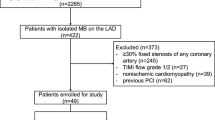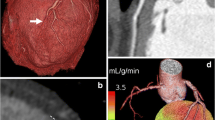Abstract
Myocardial bridges are common and often benign, but can cause hemodynamically significant obstruction of blood flow with stress. Dobutamine stress positron emission tomography/computed tomography (PET/CT) is a powerful tool for non-invasively assessing for ischemia. We present a case of using dobutamine stress PET/CT to determine the significance of a myocardial bridge.







Similar content being viewed by others
References
Lee MS, Chen CH. Myocardial bridging: An up-to-date review. J Invasive Cardiol. 2015;27:521–28.
Lin S, Tremmel JA, Yamada R, Rogers IS, Yong CM, Turcott R, et al. A novel stress echocardiography pattern for myocardial bridge with invasive structural and hemodynamic correlation. J Am Heart Assoc. 2013;2:e000097.
Tang K, Wang L, Shi R, Zheng X, Li T, Zhao X, et al. The role of myocardial perfusion imaging in evaluating patients with myocardial bridging. J Nucl Cardiol. 2011;18:117–22.
Gawor R, Kuśmierek J, Płachcińska A, Bieńkiewicz M, Drożdż J, Piotrowski G, et al. Myocardial perfusion GSPECT imaging in patients with myocardial bridging. J Nucl Cardiol. 2011;18:1059–65.
Pargaonkar VS, Rogers IS, Su J, Forsdahl SH, Kameda R, Schreiber D, et al. Accuracy of a novel stress echocardiography pattern for myocardial bridging in patients with angina and no obstructive coronary artery disease—A retrospective and prospective cohort study. Int J Cardiol. 2020;311:107–13.
Monroy-Gonzalez AG, Alexanderson-Rosas E, Prakken NH, Juarez-Orozco LE, Walls-Laguarda L, Berrios-Barcenas EA, et al. Myocardial bridging of the left anterior descending coronary artery is associated with reduced myocardial perfusion reserve: A 13 N-ammonia PET study. Int J Cardiovasc Imaging. 2019;35:375–82.
Disclosure
Dr. Abadie and Dr. Jaber have no disclosures.
Author information
Authors and Affiliations
Corresponding author
Additional information
Publisher's Note
Springer Nature remains neutral with regard to jurisdictional claims in published maps and institutional affiliations.
Supplementary Information
Below is the link to the electronic supplementary material.
Supplementary file1 (WMV 325 kb)
Figure 8: PET/CT gated images demonstrating hypokinesis of the apex and septum during stress(video).
Supplementary file2 (MP4 4403 kb)
Figure 9: Initial echocardiogram showing hypokinesis of the left ventricular (LV) apex andseptum (video).
Supplementary file3 (MP4 2520 kb)
Figure 10: Repeat echocardiogram one month later shows resolution of wall motionalabnormalities and a normal LV ejection fraction (video).
Rights and permissions
About this article
Cite this article
Abadie, B., Jaber, W. Dobutamine stress PET/CT for assessment of hemodynamic significance of coronary myocardial bridges. J. Nucl. Cardiol. 29, 1447–1451 (2022). https://doi.org/10.1007/s12350-021-02759-8
Received:
Accepted:
Published:
Issue Date:
DOI: https://doi.org/10.1007/s12350-021-02759-8




